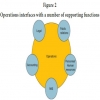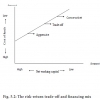Operations Management - Introduction to Operations Management
Historical Evolution of Operations Management
Posted On :
The subject Operations management has its own connection with the age old Industrial Revolution, which has started during the late 17th century in England and later spread to the rest of Europe and to the United States during the 19th century.
Historical Evolution of
Operations Management
The subject Operations management has its own connection with the age old Industrial Revolution, which has started during the late 17th century in England and later spread to the rest of Europe and to the United States during the 19th century. Prior to that time, goods were manufactured in small quantities in smaller shops / factories by the local craftsmen and their apprentices, who were mostly their family members. Under that system, it was common for one person to be responsible for making a product, such as a horse-drawn wagon or a piece of furniture, from start to finish. Only simple tools were available; the machines that we use today had not been invented.
Later, in the 18th century, many scientific inventions came into existence and changed the face of production / operations by substituting huge machines, which are operated by steam power and electric power. Perhaps the most significant of these inventions, was the steam engine; it had the ability to provide power to operate huge machineries in the factories. For example, the spinning jenny and the power looms revolutionized the textile industry. Ample supplies of coal and iron ore provided materials for generating power and making machinery. The new machines, made of iron, were much stronger and more durable than the simple wooden machines they replaced.
From the late 17th century (1770) to the early years of the 18th century, series of events took place in England which together is called the Industrial Revolution.
Industrial Revolution resulted in two major developments: widespread substitution of machine power for human power and establishment of the organized production system known as factory system.
The events that took place from 1770 to the 1800s are characterized by great inventions. The great inventions were eight in number ,with six of them having been conceived in England, one in France and one in the United States .The eight inventions are—Hargreaves Spinning Jenny, Arkwright’s Water Frame, Crompton’s Mule, Cartwright’s Power Loom, Watt’s steam engine, Berthollet’s Chlorine Bleaching Discovery,
As observed from eight inventions, most of them have to do with the spinning of yarn and weaving of cloth. This is logical from the point of view that cloth was the principal export commodity of England at that time and was in short supply owing to the considerable expansion of England’s colonial empire and its commercial trade.
The availability of machine power greatly facilitated the gathering of workers in factories that housed the machines. The large number of workers congregated in the factories, created the need for organizing them in logical ways to produce goods.
The publication of Adam Smith’s The Wealth of Nations in 1776 advocated the benefits of the division of labor or specialization of labor, which broke production of goods into small specialized tasks that were assigned to workers on production lines. Thus, the factories of late 1700s not only had developed production machinery, but also ways of planning and controlling the output of workers.
The impact of the Industrial Revolution was first felt in England. From here, it spread to other European countries and to the United States. The Industrial Revolution advanced further with the development of the gasoline engine and electricity in the 1800s. Other industries emerged and along with them new factories came into being. By the middle of 18th century, the old cottage system of production had been replaced by the large scale factory system. As days went by, production capacities expanded, demand for capital grew and labor became highly dependent on jobs and urbanized. At the commencement of the 20th century, the one element that was missing was a management –the ability to develop and use the existing facilities to produce on a large scale to meet massive markets of today.
Later, the Scientific Management Era has brought widespread changes to the practices and management of factories. The movement was spearheaded by the efficiency engineer and inventor Frederick Winslow Taylor, who is often referred to as the Father of Scientific Management. Taylor believed in a “science of management” based on observation,
The subject Operations management has its own connection with the age old Industrial Revolution, which has started during the late 17th century in England and later spread to the rest of Europe and to the United States during the 19th century. Prior to that time, goods were manufactured in small quantities in smaller shops / factories by the local craftsmen and their apprentices, who were mostly their family members. Under that system, it was common for one person to be responsible for making a product, such as a horse-drawn wagon or a piece of furniture, from start to finish. Only simple tools were available; the machines that we use today had not been invented.
Later, in the 18th century, many scientific inventions came into existence and changed the face of production / operations by substituting huge machines, which are operated by steam power and electric power. Perhaps the most significant of these inventions, was the steam engine; it had the ability to provide power to operate huge machineries in the factories. For example, the spinning jenny and the power looms revolutionized the textile industry. Ample supplies of coal and iron ore provided materials for generating power and making machinery. The new machines, made of iron, were much stronger and more durable than the simple wooden machines they replaced.
From the late 17th century (1770) to the early years of the 18th century, series of events took place in England which together is called the Industrial Revolution.
Industrial Revolution resulted in two major developments: widespread substitution of machine power for human power and establishment of the organized production system known as factory system.
The events that took place from 1770 to the 1800s are characterized by great inventions. The great inventions were eight in number ,with six of them having been conceived in England, one in France and one in the United States .The eight inventions are—Hargreaves Spinning Jenny, Arkwright’s Water Frame, Crompton’s Mule, Cartwright’s Power Loom, Watt’s steam engine, Berthollet’s Chlorine Bleaching Discovery,
As observed from eight inventions, most of them have to do with the spinning of yarn and weaving of cloth. This is logical from the point of view that cloth was the principal export commodity of England at that time and was in short supply owing to the considerable expansion of England’s colonial empire and its commercial trade.
The availability of machine power greatly facilitated the gathering of workers in factories that housed the machines. The large number of workers congregated in the factories, created the need for organizing them in logical ways to produce goods.
The publication of Adam Smith’s The Wealth of Nations in 1776 advocated the benefits of the division of labor or specialization of labor, which broke production of goods into small specialized tasks that were assigned to workers on production lines. Thus, the factories of late 1700s not only had developed production machinery, but also ways of planning and controlling the output of workers.
The impact of the Industrial Revolution was first felt in England. From here, it spread to other European countries and to the United States. The Industrial Revolution advanced further with the development of the gasoline engine and electricity in the 1800s. Other industries emerged and along with them new factories came into being. By the middle of 18th century, the old cottage system of production had been replaced by the large scale factory system. As days went by, production capacities expanded, demand for capital grew and labor became highly dependent on jobs and urbanized. At the commencement of the 20th century, the one element that was missing was a management –the ability to develop and use the existing facilities to produce on a large scale to meet massive markets of today.
Later, the Scientific Management Era has brought widespread changes to the practices and management of factories. The movement was spearheaded by the efficiency engineer and inventor Frederick Winslow Taylor, who is often referred to as the Father of Scientific Management. Taylor believed in a “science of management” based on observation,
Tags : Operations Management - Introduction to Operations Management
Last 30 days 10076 views














